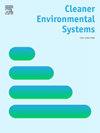Circularity in the pasta supply chain: Developing a multi-indicator framework for circular economy assessment
IF 4.9
Q2 ENGINEERING, ENVIRONMENTAL
引用次数: 0
Abstract
The shift towards circular production patterns in the agri-food supply chain is becoming increasingly essential for sustainable development. In this scenario, measuring circularity is critical for ensuring an effective and efficient transition towards such development. Given its relevance, the scientific community and standard-setting bodies are progressively focusing on identifying appropriate circularity indicators. Accordingly, most existing studies have provided broad overviews of available indicators, systematically reviewing academic and grey literature in the context of the agri-food supply chain. Considering the peculiarities of each supply chain within this sector, it is crucial to identify specific indicators in line with their characteristics, providing a practical guide for companies committed to the circular transition. However, a significant gap in research focused on identifying specific indicators for different agri-food supply chain has emerged. To fill this gap, the present research aims to provide a comprehensive framework to measure circularity within the pasta supply chain, representing an essential sector of the worldwide economy. To achieve this, a structured approach was adopted that integrates a systematic literature review with an assessment of the available standards on circular economy measurement. By implementing a rigorous selection process, a final set of 51 indicators – reclassified according to the analytical framework developed in the study – was identified for each pasta supply chain phase. Results show that most indicators could be transversally applied to the PSC. This multi-indicator framework could represent a helpful tool for the pasta industry to measure, monitor and disclose circularity performance in line with the ISO 59020:2024 standard.
面食供应链的循环性:开发循环经济评估的多指标框架
农业食品供应链向循环生产模式的转变对可持续发展越来越重要。在这种情况下,测量循环度对于确保向这种开发的有效和高效过渡至关重要。鉴于其相关性,科学界和标准制定机构正逐步侧重于确定适当的循环指标。因此,大多数现有研究提供了可用指标的广泛概述,系统地审查了农业食品供应链背景下的学术和灰色文献。考虑到该行业内每个供应链的特点,确定符合其特点的具体指标至关重要,为致力于循环转型的公司提供实用指南。然而,在确定不同农业食品供应链的具体指标方面的研究存在重大差距。为了填补这一空白,本研究旨在提供一个全面的框架来衡量意大利面供应链中的循环,代表全球经济的一个重要部门。为了实现这一目标,采用了一种结构化的方法,将系统的文献综述与对循环经济测量的现有标准的评估相结合。通过实施严格的选择过程,最终确定了51个指标,并根据研究中开发的分析框架重新分类,用于面食供应链的每个阶段。结果表明,大多数指标可以横向应用于PSC。这个多指标框架可以为面食行业提供一个有用的工具,根据ISO 59020:2024标准来测量、监控和披露循环性能。
本文章由计算机程序翻译,如有差异,请以英文原文为准。
求助全文
约1分钟内获得全文
求助全文
来源期刊

Cleaner Environmental Systems
Environmental Science-Environmental Science (miscellaneous)
CiteScore
7.80
自引率
0.00%
发文量
32
审稿时长
52 days
 求助内容:
求助内容: 应助结果提醒方式:
应助结果提醒方式:


